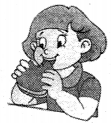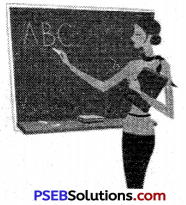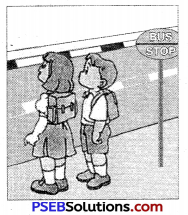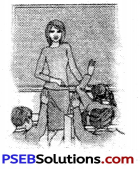Punjab State Board PSEB 6th Class Punjabi Book Solutions Chapter 19 ਭਾਰਤ ਦਾ ਲਾਲ Textbook Exercise Questions and Answers.
PSEB Solutions for Class 6 Punjabi Chapter 19 ਭਾਰਤ ਦਾ ਲਾਲ
I. ਬਹੁਵਿਕਲਪੀ ਪ੍ਰਸ਼ਨ
ਪ੍ਰਸ਼ਨ-ਹੇਠ ਲਿਖੇ ਪ੍ਰਸ਼ਨਾਂ ਦੇ ਉੱਤਰ ਅੱਗੇ ਸਹੀ (✓) ਦਾ ਨਿਸ਼ਾਨ ਲਾਓ :
(i) ਇਕਾਂਗੀ ਵਿਚ ਇਸਤਰੀ-ਪਾਤਰ ਦਾ ਕੀ ਨਾਮ ਹੈ ?
(ਉ) ਬਲਬੀਰ ਕੌਰ
(ਅ) ਰਣਬੀਰ ਕੌਰ
(ਇ) ਰਣਧੀਰ ਕੌਰ ।
ਉੱਤਰ :
(ਅ) ਰਣਬੀਰ ਕੌਰ ✓
(ii) ਇਕਾਂਗੀ ਵਾਲੀ ਘਟਨਾ ਕਿਸ ਇਤਿਹਾਸਿਕ ਦਿਨ ਵਾਲੀ ਹੈ ?
(ਉ) 26 ਜਨਵਰੀ
(ਅ) 15 ਅਗਸਤ
(ਈ) 2 ਅਕਤੂਬਰ ।
ਉੱਤਰ :
(ਉ) 26 ਜਨਵਰੀ ✓
(iii) ਮਾਂ ਦੇ ਜਾਣ ਤੋਂ ਬਾਅਦ ਬੱਚਿਆਂ ਕੋਲ ਕੌਣ ਆ ਗਿਆ ਸੀ ?
(ਉ) ਚਾਚਾ ।
(ਅ) ਤਾਇਆ
(ਇ) ਮਾਮਾ ।
ਉੱਤਰ :
(ਇ) ਮਾਮਾ । ✓
![]()
(iv) ਕੀ ਮਾਮਾ ਅਸਲ ਵਿਚ ਬੱਚਿਆਂ ਦਾ ਮਾਮਾ ਸੀ ?
(ਉ) ਹਾਂ ।
(ਅ) ਨਹੀਂ ।
(ਈ) ਸਕਾ ਮਾਮਾ ਨਹੀਂ ਸੀ ।
ਉੱਤਰ :
(ਅ) ਨਹੀਂ । ✓
(v) ਮਾਮੇ ਦੇ ਭੇਸ ਵਿਚ ਆਏ ਵਿਅਕਤੀ ਨੇ ਖੁਦ ਨੂੰ ਕਿਸ ਦੇਸ਼ ਤੋਂ ਆਇਆ ਦੱਸਿਆ ?
(ਉ) ਸਿੰਘਾਪੁਰ
(ਅ) ਮਲਾਇਆ
(ਇ) ਅਫ਼ਰੀਕਾ ।
ਉੱਤਰ :
(ਅ) ਮਲਾਇਆ ✓
II. ਛੋਟੇ ਉੱਤਰ ਵਾਲੇ ਪ੍ਰਸ਼ਨ
ਪ੍ਰਸ਼ਨ 1.
ਖ਼ਾਲੀ ਸਥਾਨ ਭਰੋ : ਜ਼ੋਰ-ਜ਼ੋਰ, ਕਸ਼ਮੀਰ, ਅਫ਼ਰੀਕਾ, ਬਾਲਕ, ਡਰ ।
(i) ਮੈਨੂੰ ਤਾਂ ……………… ਲੱਗਣ ਲੱਗ ਪਿਆ ।
(ii) ਸਾਡੇ ਮਾਮਾ ਜੀ ਤਾਂ ……………… ਵਿਚ ਰਹਿੰਦੇ ਹਨ ।
(iii) ਸੂਬੇਦਾਰ ਅਰਜਨ ਸਿੰਘ ……………. ਦੀ ਲੜਾਈ ਵਿਚ ਸ਼ਹੀਦ ਹੋਏ ।
(iv) ਦਰਵਾਜ਼ਾ ……………… ਨਾਲ ਖੜਕਦਾ ਹੈ ।
(v) ਤੂੰ ਬਹੁਤ ਸਿਆਣਾ ……………… ਹੈਂ ।
ਉੱਤਰ :
(i) ਮੈਨੂੰ ਤਾਂ ਡਰ ਲੱਗਣ ਲੱਗ ਪਿਆ ।
(ii) ਸਾਡੇ ਮਾਮਾ ਜੀ ਤਾਂ ਅਫ਼ਰੀਕਾ ਵਿਚ ਰਹਿੰਦੇ ਹਨ ।
(iii) ਸੁਬੇਦਾਰ ਅਰਜਨ ਸਿੰਘ ਕਸ਼ਮੀਰ ਦੀ ਲੜਾਈ ਵਿਚ ਸ਼ਹੀਦ ਹੋਏ ।
(iv) ਦਰਵਾਜ਼ਾ ਜ਼ੋਰ-ਜ਼ੋਰ ਨਾਲ ਖੜਕਦਾ ਹੈ ।
(v) ਤੂੰ ਬਹੁਤ ਸਿਆਣਾ ਬਾਲਕ ਹੈਂ।
![]()
III. ਸੰਖੇਪ ਉੱਤਰ ਵਾਲੇ ਪ੍ਰਸ਼ਨ
ਪ੍ਰਸ਼ਨ 1.
ਵਾਕਾਂ ਵਿਚ ਵਰਤੋ :
ਜਸ਼ਨ, ਸਟੇਸ਼ਨ, ਹੋਣਹਾਰ, ਨਕਦੀ, ਵੀਰ-ਚੱਕਰ, ਕਸ਼ਟ ।
ਉੱਤਰ :
1.ਜਸ਼ਨ (ਖ਼ੁਸ਼ੀ ਦਾ ਸਮਾਗਮ) – ਚੋਣਾਂ ਵਿਚ ਜੇਤੂ ਧਿਰ ਖੂਬ ਜਸ਼ਨ ਮਨਾ ਰਹੀ ਸੀ ।
2. ਸਟੇਸ਼ਨ (ਰੁਕਣ ਜਾਂ ਸਥਾਪਿਤ ਹੋਣ ਦੀ ਥਾਂ) – ਗੱਡੀ ਜਲੰਧਰ ਸਟੇਸ਼ਨ ਤੋਂ ਚਲ ਪਈ ਹੈ।
3. ਹੋਣਹਾਰ (ਤਰੱਕੀ ਕਰਨ ਵਾਲਾ) – ਇਹ ਬੱਚਾ ਬੜਾ ਹੋਣਹਾਰ ਜਾਪਦਾ ਹੈ । ਪ੍ਰਾਇਮਰੀ ਵਿਚ ਹੀ ਇਹ ਸਭ ਤੋਂ ਵੱਧ ਨੰਬਰ ਲੈਂਦਾ ਰਿਹਾ ਹੈ ।
4. ਨਕਦੀ (ਸਿੱਕੇ ਤੇ ਨੋਟਾਂ ਦੇ ਰੂਪ ਵਿਚ ਮੁਦਰਾ) – ਮੈਂ 50,000 ਰੁਪਏ ਨਕਦ ਦੇ ਕੇ ਇਹ ਮੱਝ ਖ਼ਰੀਦੀ ਸੀ ।
5. ਵੀਰ-ਚੱਕਰ (ਫ਼ੌਜੀਆਂ ਨੂੰ ਬਹਾਦਰੀ ਬਦਲੇ ਮਿਲਣ ਵਾਲਾ ਕੌਮੀ ਪੁਰਸਕਾਰ) – 26 ਜਨਵਰੀ ਨੂੰ ਦੋ ਬਹਾਦਰ ਫ਼ੌਜੀਆਂ ਨੂੰ ਵੀਰ-ਚੱਕਰ ਦੇ ਕੇ ਸਨਮਾਨਿਆ ਗਿਆ ।
6. ਕਸ਼ਟ (ਦੁੱਖ-ਦੇਸ਼) – ਭਗਤਾਂ ਨੇ ਜੇਲ੍ਹਾਂ ਵਿਚ ਬਹੁਤ ਕਸ਼ਟ ਸਹੇ ।
![]()
ਪ੍ਰਸ਼ਨ 2.
ਸ਼ਮਸ਼ੇਰ ਦੇ ਪਿਤਾ ਜੀ ਦਾ ਕੀ ਨਾਂ ਸੀ ? ਉਹ ਕਿਸ ਲੜਾਈ ਵਿਚ ਸ਼ਹੀਦ ਹੋ ਗਏ ਸਨ ?
ਉੱਤਰ :
ਸ਼ਮਸ਼ੇਰ ਦੇ ਪਿਤਾ ਜੀ ਦਾ ਨਾਂ ਸੂਬੇਦਾਰ ਅਰਜਨ ਸਿੰਘ ਸੀ । ਉਹ ਪਿਛਲੇ ਸਾਲ ਕਸ਼ਮੀਰ ਦੀ ਲੜਾਈ ਵਿਚ ਸ਼ਹੀਦ ਹੋ ਗਏ ਸਨ ।
ਪ੍ਰਸ਼ਨ 3.
ਬੱਚਿਆਂ ਨੇ ਮਾਮੇ ਦੇ ਰੂਪ ਵਿਚ ਆਏ ਚੋਰ ਨੂੰ ਪੁਲਿਸ ਦੇ ਹਵਾਲੇ ਕਿਵੇਂ ਕੀਤਾ ?
ਉੱਤਰ :
ਸ਼ਮਸ਼ੇਰ ਨੇ ਬਹੁਤ ਚਲਾਕੀ ਨਾਲ ਚੋਰ ਨੂੰ ਸਟੋਰ ਵਿਚ ਵਾੜ ਕੇ ਬਾਹਰੋਂ ਕੁੰਡਾ ਲਾ ਦਿੱਤਾ । ਫੇਰ ਉਸ ਨੇ ਬਾਣੇ ਟੈਲੀਫ਼ੋਨ ਕਰ ਦਿੱਤਾ । ਪੁਲਿਸ ਦੇ ਆਉਣ ਤੋਂ ਪਹਿਲਾਂ ਚੋਰ ਨੇ ਰੋਸ਼ਨਦਾਨ ਦਾ ਸ਼ੀਸ਼ਾ ਤੋੜ ਕੇ ਨੱਸਣ ਦੀ ਕੋਸ਼ਿਸ਼ ਕੀਤੀ । ਪਰ ਸ਼ਮਸ਼ੇਰ ਨੇ ਏਅਰ-ਰੀਨ ਚਲਾ ਕੇ ਉਸ ਨੂੰ ਅੰਦਰ ਹੀ ਰਹਿਣ ਲਈ ਮਜਬੂਰ ਕਰ ਦਿੱਤਾ । ਏਨੇ ਵਿਚ ਪੁਲਿਸ ਆ ਗਈ ਤੇ ਚੋਰ ਫੜਿਆ ਗਿਆ ।
ਪ੍ਰਸ਼ਨ.4.
ਰਣਬੀਰ ਨੇ ਸ਼ਮਸ਼ੇਰ ਨੂੰ “ਸ਼ੇਰ ਪੁੱਤਰ’ ਕਿਉਂ ਕਿਹਾ ?
ਉੱਤਰ :
ਸ਼ਮਸ਼ੇਰ ਨੇ ਬਹਾਦਰੀ ਤੋਂ ਕੰਮ ਲੈਂਦੇ ਹੋਏ ਚੋਰ ਨੂੰ ਸਟੋਰ ਵਿਚ ਬੰਦ ਕਰ ਦਿੱਤਾ । ਫੇਰ ਉਸ ਨੇ ਹੌਸਲੇ ਨਾਲ ਪੁਲਿਸ ਬੁਲਵਾ ਲਈ । ਜਦੋਂ ਚੋਰ ਰੋਸ਼ਨਦਾਨ ਵਿਚੋਂ ਭੱਜ ਕੇ ਨਿਕਲਣ ਦੀ ਕੋਸ਼ਿਸ਼ ਕਰਨ ਲੱਗਾ, ਤਾਂ ਉਸ ਨੇ ਏਅਰ-ਰੀਨ ਨਾਲ ਉਸ ਨੂੰ ਸਟੋਰ ਵਿਚੋਂ ਬਾਹਰ ਨਾ ਨਿਕਲਣ ਦਿੱਤਾ । ਇਨ੍ਹਾਂ ਗੱਲਾਂ ਤੋਂ ਪ੍ਰਭਾਵਿਤ ਹੋ ਕੇ ਰਣਬੀਰ ਨੇ ਸ਼ਮਸ਼ੇਰ ਨੂੰ ‘ਸ਼ੇਰ-ਪੁੱਤਰ’ ਕਿਹਾ
ਪ੍ਰਸ਼ਨ 5.
ਥਾਣੇਦਾਰ ਨੇ ਸ਼ਮਸ਼ੇਰ ਬਾਰੇ ਕੀ ਕਿਹਾ ?
ਉੱਤਰ :
ਬਾਣੇਦਾਰ ਨੇ ਸ਼ਮਸ਼ੇਰ ਬਾਰੇ ਕਿਹਾ ਕਿ ਉਸ ਨੇ ਨਾਮੀ ਚੋਰ ਫੜਿਆ ਹੈ, ਜਿਸ ਬਦਲੇ ਉਸ ਨੂੰ ਪੰਜ ਸੌ ਰੁਪਏ ਇਨਾਮ ਮਿਲੇਗਾ : ਉਹ ਉਸ ਦੀ ਮਾਂ ਰਣਬੀਰ ਨੂੰ ਕਹਿੰਦਾ ਹੈ ਕਿ ਉਹ ਭਾਗਾਂਵਾਲੀ ਹੈ, ਜਿਸ ਦੇ ਘਰ ਬਹਾਦਰ ਪੁੱਤਰ ਜੰਮਿਆ ਹੈ, ਜੋ ਖ਼ਾਨਦਾਨ ਦਾ ਨਾਂ ਰੌਸ਼ਨ ਕਰੇਗਾ ।
ਪ੍ਰਸ਼ਨ 6.
ਸ਼ਮਸ਼ੇਰ ਦੇ ਚਰਿੱਤਰ ਬਾਰੇ ਤਿੰਨ-ਚਾਰ ਸਤਰਾਂ ਲਿਖੋ ।
ਉੱਤਰ :
ਸ਼ਮਸ਼ੇਰ ਸ਼ਹੀਦ ਸੂਬੇਦਾਰ ਅਰਜਨ ਸਿੰਘ ਦਾ ਪੁੱਤਰ ਸੀ । ਉਸਦੀ ਭੈਣ ਦਾ ਨਾਂ ਨਿਰਮਲ ਹੈ । ਉਹ ਬੜਾ ਹੁਸ਼ਿਆਰ ਤੇ ਦਲੇਰ ਲੜਕਾ ਹੈ । ਉਹ ਮਾਮੇ ਦੇ ਰੂਪ ਵਿਚ ਘਰ ਆਏ ਚੋਰ ਦੀ ਹਕੀਕਤ ਨੂੰ ਸਮਝ ਤੇ ਉਸਨੂੰ ਗੱਲਾਂ ਵਿਚ ਲਾ ਕੇ ਕਮਰੇ ਦੇ ਅੰਦਰ ਬੰਦ ਕਰ ਦਿੰਦਾ ਹੈ ਅਤੇ ਉਸਦੀਆਂ ਧਮਕੀਆਂ ਦੀ ਪ੍ਰਵਾਹ ਨਾ ਕਰਦਾ ਹੋਇਆ ਏਅਰ ਗੰਨ ਦਾ ਫਾਇਰ ਕਰ ਕੇ ਉਸਨੂੰ ਡਰਾ ਦਿੰਦਾ ਹੈ । ਅੰਤ ਉਹ ਉਸਨੂੰ ਪੁਲਿਸ ਕੋਲ ਫੜਾ ਦਿੰਦਾ ਹੈ । ਬਾਣੇਦਾਰ ਉਸਦੀ ਬਹਾਦਰੀ ਦੀ ਪ੍ਰਸੰਸਾ ਕਰਦਿਆਂ ਉਸਨੂੰ ਇਨਾਮ ਦੁਆਉਣ ਦੀ ਗੱਲ ਕਹਿੰਦਾ ਹੈ ।
![]()
ਪ੍ਰਸ਼ਨ 7.
ਹੇਠ ਲਿਖੇ ਸ਼ਬਦਾਂ ਨੂੰ ਪੰਜਾਬੀ ਵਿਚ ਲਿਖਿਆ ਹੈ, ਤੁਸੀਂ ਹਿੰਦੀ ਅਤੇ ਅੰਗਰੇਜ਼ੀ ਵਿਚ ਵੀ ਲਿਖੋ :
ਪੰਜਾਬੀ – ਹਿੰਦੀ – ਅੰਗਰੇਜ਼ੀ
ਨਕਸ਼ਾ – …………. – ………….
ਸੁਗਾਤ – …………. – ………….
ਜ਼ੇਵਰ – …………. – ………….
ਫੁੱਲ – …………. – ………….
ਚਾਹ – …………. – ………….
ਉੱਤਰ :
ਪੰਜਾਬੀ – ਹਿੰਦੀ – ਅੰਗਰੇਜ਼ੀ
ਨਕਸ਼ਾ – मानचित्र – Map
ਸੁਗਾਤ – पुरस्कार – Gift
ਜ਼ੇਵਰ – अभूषण – Ornaments
ਫੁੱਲ – फूल – Flower
ਚਾਹ – चाय – Tea
IV. ਵਿਆਕਰਨ
ਪ੍ਰਸ਼ਨ 1.
ਹੇਠ ਲਿਖੇ ਵਾਕਾਂ ਵਿਚੋਂ ਵਿਸ਼ੇਸ਼ਣ-ਸ਼ਬਦ ਚੁਣੋ :
(i) ਸ਼ਮਸ਼ੇਰ ਪੰਦਰਾਂ ਕੁ ਸਾਲ ਦਾ ਸੀ
(ii) ਗਲੀ ਸੁੰਨ-ਮਸੁੰਨੀ ਪਈ ਸੀ ।
(iii) ਵਿਅਕਤੀ ਨੇ ਸ਼ਮਸ਼ੇਰ ਨੂੰ ਬਹੁਤ ਸਾਰੇ ਨੋਟ ਵਿਖਾਏ ।
(iv) ਫ਼ੌਜੀਆਂ ਕੋਲ ਬਹੁਤ ਥੋੜ੍ਹਾ ਸਮਾਨ ਹੁੰਦਾ ਹੈ ।
(v) ਮੇਰਾ ਭਾਣਜਾ ਬਹੁਤ ਹੋਣਹਾਰ ਲੜਕਾ ਹੈ ।
ਉੱਤਰ :
(i) ਪੰਦਰਾਂ ਕੁ !
(ii) ਸੁੰਨ-ਮਸੁੰਨੀ ।
(iii) ਬਹੁਤ ਸਾਰੇ ।
(iv) ਬਹੁਤ ਥੋੜ੍ਹਾ ।
(v) ਬਹੁਤ ਹੋਣਹਾਰ ।
![]()
V. ਵਿਦਿਆਰਥੀਆਂ ਲਈ
ਪ੍ਰਸ਼ਨ 1.
ਤੁਸੀਂ ਭਾਰਤ ਦਾ ਲਾਲ ਇਕਾਂਗੀ ਵਿਚੋਂ ਕੀ ਸਿੱਖਿਆ ਹੈ ? ਅਚਾਨਕ ਆਈ ਬਿਪਤਾ ਵਿਚ ਤੁਸੀਂ ਕਿਵੇਂ ਉਸ ਦਾ ਸਾਮਣਾ ਕਰਨਾ ਹੈ ?
ਉੱਤਰ :
ਇਸ ਇਕਾਂਗੀ ਵਿਚੋਂ ਅਸੀਂ ਇਹ ਸਿੱਖਿਆ ਹੈ ਕਿ ਅਚਾਨਕ ਆਂਈ ਬਿਪਤਾਂ ਦਾ ਬਹਾਦਰੀ ਤੇ ਮਨ ਦੀ ਇਕਾਗਰਤਾ ਨਾਲ ਟਾਕਰਾ ਕਰਨਾ ਚਾਹੀਦਾ ਹੈ । ਅਜਿਹੀ ਸਥਿਤੀ ਵਿਚ ਸਾਨੂੰ ਨਾ ਘਬਰਾਉਣਾ ਚਾਹੀਦਾ ਹੈ ਤੇ ਨਾ ਹੀ ਡਰਨਾ ਚਾਹੀਦਾ ਹੈ, ਸਗੋਂ ਹੌਸਲੇ ਨਾਲ ਸ਼ਾਂਤ ਰਹਿੰਦਿਆਂ ਅਜਿਹੇ ਹਾਲਾਤ ਪੈਦਾ ਕਰਨੇ ਚਾਹੀਦੇ ਹਨ ਕਿ ਮੁਸ਼ਕਿਲ ਵਿਚੋਂ ਨਿਕਲਣ ਦਾ ਕੋਈ ਹੱਲ ਨਿਕਲ ਸਕੇ । ਮੌਕਾ ਮਿਲਣ ਉੱਤੇ ਪੁਲਿਸ ਨੂੰ ਵੀ ਬੁਲਾ ਲੈਣਾ ਚਾਹੀਦਾ ਹੈ ।
ਔਖੇ ਸ਼ਬਦਾਂ ਦੇ ਅਰਥ :
ਪ੍ਰਭਾਵਸ਼ਾਲੀ-ਅਸਰ ਰੱਖਣ ਵਾਲੀ, ਰੋਅਬਦਾਰ । ਗੰਭੀਰ-ਜਿਸ ਦੇ ਚਿਹਰੇ ਤੇ ਕੋਈ ਹਾਵ-ਭਾਵ ਨਾ ਹੋਵੇ । ਆਦਰ-ਸਤਿਕਾਰ (ਜਸ਼ਨ-ਮੌਜ-ਮੇਲਾ । ਡਰਪੋਕਡਰ ਜਾਣ ਵਾਲਾ । ਓਦਣ-ਉਸ ਦਿਨ 1 ਸਟੋਰ-ਸਮਾਨ ਰੱਖਣ ਵਾਲਾ ਕਮਰਾ । ਅੰਗੀਠੀ ਪੋਸ਼-ਅੰਗੀਠੀ ਉੱਤੇ ਪਾਇਆ ਕੱਪੜਾ । ਫੁਰਤੀ-ਚੁਸਤੀ ! ਸੁਗਾਤ-ਤੋਹਫ਼ਾ । ਖ਼ੁਦ-ਆਪ ॥ ਸਰੀਫ ਲਿਆਓ-ਆਓ । ਸਹਿਮਿਆ-ਡਰਿਆ । ਹਵਾਲਾਤ-ਥਾਣੇ ਵਿਚ ਬਣੀ ਜੇਲ । ਮਹਿਮਾਨ-ਪਾਹੁਣਾ । ਦਲੇਰ-ਹੌਸਲੇ ਵਾਲਾ । ਖੁਸ਼-ਕਿਸਮਤ-ਚੰਗੀ ਕਿਸਮਤ ਵਾਲਾ । ਖ਼ਾਨਦਾਨ-ਟੱਬਰ । ਪਾਜੀ-ਕਮੀਨਾ, ਨੀਚ । ਕਸ਼ਟ-ਦੁੱਖ ।
ਭਾਰਤ ਦਾ ਲਾਲ Summary
ਭਾਰਤ ਦਾ ਲਾਲ ਪਾਠ ਦਾ ਸਾਰ
ਪਰਦਾ ਉੱਠਣ ਸਮੇਂ ਪੈਂਤੀ ਕੁ ਸਾਲਾਂ ਦੀ ਇਕ ਗੰਭੀਰ ਤੇ ਪ੍ਰਭਾਵਸ਼ਾਲੀ ਇਸਤਰੀ ਰਣਬੀਰ ਅੰਗੀਠੀ ਉੱਪਰ ਪਈ ਫੋਟੋ ਨੂੰ ਆਪਣੇ ਸਫ਼ੈਦ ਦੁਪੱਟੇ ਨਾਲ ਪੂੰਝ ਕੇ ਆਦਰ ਨਾਲ ਰੱਖਦੀ ਹੈ । ਉਸਦਾ ਪੁੱਤਰ ਸ਼ਮਸ਼ੇਰ 15 ਕੁ ਸਾਲਾਂ ਦਾ ਹੈ ਤੇ ਧੀ ਨਿਰਮਲ ਸੱਤਾਂ ਕੁ ਸਾਲਾਂ ਦੀ । ਦੋਵੇਂ ਫੋਟੋ ਅੱਗੇ ਸਿਰ ਚੁਕਾਉਂਦੇ ਹਨ । ਇਹ ਫੋਟੋ ਉਨ੍ਹਾਂ ਦੇ ਬਾਪ ਸੂਬੇਦਾਰ ਅਰਜਨ ਸਿੰਘ ਦੀ ਹੈ, ਜਿਹੜਾ ਕਸ਼ਮੀਰ ਵਿਚ ਮਾਰਿਆ ਗਿਆ ਸੀ ।
ਹਣਬੀਰ ਸ਼ਮਸ਼ੇਰ ਨੂੰ ਧੂਫ਼ ਧੁਖਾਉਣ ਲਈ ਕਹਿੰਦੀ ਹੈ । ਉਹ ਆਖਦੀ ਹੈ ਕਿ ਉਹ ਫੁੱਲਾਂ ਦਾ ਹਾਰ ਲੈ ਕੇ ਆਉਂਦੀ ਹੈ ਤੇ ਨਾਲੇ ਗੁਰਦੁਆਰੇ ਮੱਥਾ ਟੇਕ ਆਉਂਦੀ ਹੈ । ਉਹ ਉਸਨੂੰ ਘਰ ਦਾ ਕੁੰਡਾ ਲਾ ਲੈਣ ਲਈ ਕਹਿੰਦੀ ਹੈ, ਕਿਉਂਕਿ ਲੋਕ 26 ਜਨਵਰੀ ਦੇ ਜਸ਼ਨ ਦੇਖਣ ਗਏ ਹੋਣ ਕਰਕੇ ਗਲੀ ਖਾਲੀ ਪਈ ਸੀ । ਨਿਰਮਲ ਵੀ ਝਾਕੀਆਂ ਦੇਖਣ ਦੀ ਇੱਛਾ ਪ੍ਰਗਟ ਕਰਦੀ ਹੈ ।
ਰਣਬੀਰ ਦੇ ਜਾਣ ਮਗਰੋਂ ਸ਼ਮਸ਼ੇਰ ਨਿਰਮਲ ਨੂੰ ਕਹਿੰਦਾ ਹੈ ਕਿ ਜੇਕਰ ਕੋਈ ਚੋਰ ਆਇਆ, ਤਾਂ ਉਹ ਉਸਨੂੰ ਬੰਦੂਕ ਨਾਲ ਉਡਾ ਦੇਵੇਗਾ । ਉਹ ਨਿਰਮਲ ਨੂੰ ਇਹ ਵੀ ਦੱਸਦਾ ਹੈ ਕਿ ਉਸਦੇ ਪਿਤਾ ਜੀ ਕਦੇ ਵੀ ਨਹੀਂ ਆਉਣਗੇ । ਉਨ੍ਹਾਂ ਦੇ ਮਾਤਾ ਜੀ ਐਵੇਂ ਉਸਦਾ ਦਿਲ ਰੱਖਣ ਲਈ ਕਹਿੰਦੇ ਹਨ ਕਿ ਉਹ ਹਸਪਤਾਲ ਵਿਚ ਹਨ ।
ਇੰਨੇ ਨੂੰ ਇਕ ਆਦਮੀ ਅੰਦਰ ਝਾਕਦਾ ਹੈ । ਨਿਰਮਲ ਡਰ ਜਾਂਦੀ ਹੈ । ਉਸਦੇ ਪੁੱਛਣ ‘ਤੇ ਉਹ ਉਸਨੂੰ ਆਪਣੀ ਮਾਂ ਦਾ ਨਾਂ ਦੱਸਦੇ ਹਨ । ਉਹ ਉਨ੍ਹਾਂ ਦੇ ਬਾਪ ਦਾ ਨਾਂ ਵੀ ਪੁੱਛਦਾ ਹੈ । ਉਹ ਸ਼ਮਸ਼ੇਰ ਨੂੰ ਜੱਫ਼ੀ ਵਿਚ ਲੈ ਕੇ ਕਹਿੰਦਾ ਹੈ ਕਿ ਉਹ ਟਿਕਾਣੇ ਪਹੁੰਚ ਗਿਆ ਹੈ । ਉਹ ਦੱਸਦਾ ਹੈ ਕਿ ਉਹ ਉਨ੍ਹਾਂ ਦਾ ਮਾਮਾ ਹੈ ਤੇ ਮਲਾਇਆ ਤੋਂ ਆਇਆ ਹੈ । ਸ਼ਮਸ਼ੇਰ ਕਹਿੰਦਾ ਹੈ ਕਿ ਉਨ੍ਹਾਂ ਦਾ ਮਾਮਾ ਤਾਂ ਅਫ਼ਰੀਕਾ ਵਿੱਚ ਹੈ । ਉਹ ਕਹਿੰਦਾ ਹੈ ਕਿ ਉਹ ਅਫ਼ਰੀਕਾ ਤੋਂ ਆਉਂਦਾ ਰਾਹ ਵਿਚ ਮਲਾਇਆ ਵਿਚ ਰੁਕ ਗਿਆ ਸੀ । ਸ਼ਮਸ਼ੇਰ ਕਹਿੰਦਾ ਹੈ ਕਿ ਅਫ਼ਰੀਕਾ ਕਿਸੇ ਹੋਰ ਪਾਸੇ ਹੈ ਤੇ ਮਲਾਇਆ ਕਿਸੇ ਹੋਰ ਪਾਸੇ । ਉਹ ਸਮਝ ਲੈਂਦਾ ਹੈ ਕਿ ਉਹ ਅਸਲ ਵਿਚ ਉਨ੍ਹਾਂ ਦਾ ਮਾਮਾ ਨਹੀਂ, ਸਗੋਂ ਕੋਈ ਚੋਰ ਹੈ । ਮਾਮਾ ਉਨ੍ਹਾਂ ਤੋਂ ਉਨ੍ਹਾਂ ਦੀ ਮਾਤਾ ਬਾਰੇ ਪੁੱਛਦਾ ਹੈ । ਸ਼ਮਸ਼ੇਰ ਕਹਿੰਦਾ ਹੈ ਕਿ ਉਹ ਹੁਣੇ ਘਰੋਂ ਬਾਹਰ ਨਿਕਲੇ ਹਨ । ਕੀ ਉਸਨੂੰ ਰਾਹ ਵਿਚ ਮਿਲੇ ਨਹੀਂ ? ਮਾਮਾ ਕਹਿੰਦਾ ਹੈ ਕਿ ਉਹ ਚਿਰ ਪਿੱਛੋਂ ਆਇਆ ਹੈ । ਇਸ਼ ਕਰਕੇ ਹੋ ਸਕਦਾ ਹੈ ਕਿ ਭੈਣ ਨੇ ਉਸਨੂੰ ਪਛਾਣਿਆ ਨਾ ਹੋਵੇ । ਉਸਦਾ ਆਪਣਾ ਧਿਆਨ ਘਰ ਲੱਭਣ ਵਿਚ ਹੋਣ ਕਰਕੇ ਉਸਨੂੰ ਉਸਦਾ ਪਤਾ ਹੀ ਨਹੀਂ ਲੱਗਾ !
ਸ਼ਮਸ਼ੇਰ ਤੇ ਨਿਰਮਲ ਉਸਨੂੰ ਚਾਹ ਪਾਣੀ ਪੁੱਛਦੇ ਹਨ । ਉਹ ਅਟੈਚੀ ਖੋਲ੍ਹ ਕੇ ਉਨ੍ਹਾਂ ਨੂੰ ਕਹਿੰਦਾ ਹੈ ਕਿ ਉਹ ਉਨ੍ਹਾਂ ਲਈ ਵਲੈਤੀ ਖਿਡੌਣੇ ਲਿਆਇਆ ਹੈ । ਨਿਰਮਲ ਤੇ ਸ਼ਮਸ਼ੇਰ ਪਛਾਣ ਲੈਂਦੇ ਹਨ ਕਿ ਇਹੋ ਜਿਹਾ ਖਿਡੌਣਾ ਉੱਨ੍ਹਾਂ ਇਕ ਦਿਨ ਕਨਾਟ ਪਲੇਸ ਵਿਚ ਦੇਖਿਆ ਸੀ । ਮਾਮਾ ਉਨ੍ਹਾਂ ਨੂੰ ਕਹਿੰਦਾ ਹੈ ਕਿ ਉਹ ਖਿਡੌਣਿਆਂ ਨਾਲ ਖੇਡਣ ਤੇ ਉਹ ਉਨ੍ਹਾਂ ਦਾ ਘਰ ਦੇਖਦਾ ਹੈ । ਸ਼ਮਸ਼ੇਰ ਕਹਿੰਦਾ ਹੈ ਕਿ ਉਹ ਉਸਨੂੰ ਆਪਣਾ ਘਰ ਆਪ ਹੀ ਦਿਖਾਉਂਦਾ ਹੈ । ਕਮਰੇ ਦੇਖਦਾ ਹੋਇਆ ਉਹ ਪੁੱਛਦਾ ਹੈ ਕਿ ਉਹ ਰਾਤ ਨੂੰ ਕਿੱਥੇ ਸੌਂਦੇ ਹਨ । ਉਹ ਆਖਦਾ । ਹੈ ਕਿ ਇੱਥੇ ਹੀ । ਫਿਰ ਉਹ ਉਨ੍ਹਾਂ ਦੀ ਮਾਤਾ ਦੇ ਗਹਿਣਿਆਂ ਬਾਰੇ ਪੁੱਛਦਾ ਹੈ ਕਿ ਉਹ ਕਿੱਥੇ ਰੱਖਦੀ ਹੈ ।
ਸ਼ਮਸ਼ੇਰ ਉਸਨੂੰ ਸਟੋਰ ਵਿਚ ਭੇਜ ਕੇ ਬਾਹਰੋਂ ਕੁੰਡੀ ਲਾ ਦਿੰਦਾ ਹੈ ਅਤੇ ਬੜੀ ਫੁਰਤੀ ਨਾਲ ਗੁਆਂਢੀਆਂ ਦੇ ਘਰ ਜਾ ਕੇ ਪੁਲਿਸ ਨੂੰ ਚੋਰ ਫੜਾਉਣ ਲਈ ਫੋਨ ਕਰ ਆਉਂਦਾ ਹੈਂ । ਇੰਨੇ ਨੂੰ ਪੁਲਿਸ ਆ ਜਾਂਦੀ ਹੈ । ਜਦੋਂ ਉਹ ਦਰਵਾਜ਼ਾ ਖੋਲ੍ਹ ਕੇ ਅੰਦਰ ਜਾਂਦੇ ਹਨ, ਤਾਂ ਉਨ੍ਹਾਂ ਨੂੰ ਪਤਾ ਲਗਦਾ ਹੈ ਕਿ ਉਹ ਤਾਂ ਨਾਮੀ ਚੋਰ ਖੜਕਾ ਹੈ । ਉਨ੍ਹਾਂ ਨੇ ਦੱਸਿਆ ਕਿ ਉਹ ਕਈ ਘਰਾਂ ਦੇ ਬੱਚਿਆਂ ਦਾ ਮਾਮਾ ਬਣ ਚੁੱਕਾ ਹੈ । ਇੰਨੇ ਨੂੰ ਰਣਬੀਰ ਦੋ-ਚਾਰ ਆਂਢੀਆਂ – ਗੁਆਂਢੀਆਂ ਨਾਲ ਘਬਰਾਈ ਹੋਈ ਅੰਦਰ ਆਉਂਦੀ ਹੈ ਅਤੇ ਸ਼ਮਸ਼ੇਰ ਤੋਂ ਪੁੱਛਦੀ ਹੈ ਕਿ ਕੀ ਗੱਲ ਹੈ । ਸ਼ਮਸ਼ੇਰ ਆਖਦਾ ਹੈ ਕਿ ਮਾਤਾ ਜੀ, ਘਬਰਾਓ ਨਹੀਂ, ਮਾਮਾ ਜੀ ਫੜੇ ਗਏ ਹਨ ।
ਥਾਣੇਦਾਰ ਰਣਬੀਰ ਨੂੰ ਆਖਦਾ ਹੈ ਕਿ ਉਸ ਦੇ ਪੁੱਤਰ ਨੇ ਅੱਜ ਇਕ ਨਾਮੀ ਚੋਰ ਨੂੰ ਫੜਿਆ ਹੈ । ਇਹ ਸ਼ਹਿਰ ਵਿਚ ਕਈ ਘਰਾਂ ਨੂੰ ਲੁੱਟ ਚੁੱਕਾ ਹੈ । ਇਸ ਨੂੰ ਪੰਜ ਸੌ ਰੁਪਿਆ ਇਨਾਮ ਮਿਲੇਗਾ । ਫੇਰ ਉਹ ਅੱਗੇ ਹੋਰ ਆਖਦਾ ਹੈ ਕਿ ਭੈਣ, ਤੂੰ ਬਹੁਤ ਭਾਗਾਂ ਵਾਲੀ ਏ । ਬਹਾਦਰ ਪਿਤਾ ਦੇ ਘਰ ਬਹਾਦਰ ਪੁੱਤਰ ਪੈਦਾ ਹੋਇਆ । ਇਹ ਬੱਚਾ ਖ਼ਾਨਦਾਨ ਦਾ ਨਾਂ ਰੋਸ਼ਨ ਕਰੇਗਾ। ਭਾਰਤ ਨੂੰ ਇਹੋ ਜਿਹੇ ਲਾਲਾ ਦੀ ਲੋੜ ਹੈ । ਉਹ ਸਿਪਾਹੀ ਨੂੰ ਚੋਰ ਮਾਮੇ ਨੂੰ ਥਾਣੇ ਲਿਜਾਣ ਲਈ ਆਖਦਾ ਹੈ ! ਰਣਬੀਰ ਅਤੇ ਸ਼ਮਸ਼ੇਰ ਪੁਲਿਸ ਨੂੰ ਹੱਥ ਜੋੜ ਕੇ ਵਿਦਾ ਕਰਦੇ ਹਨ ।

























